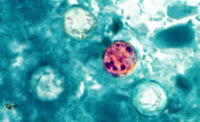Researchers Call for Improved Surveillance of Yersinia, an Underestimated Threat to Food Safety

Image credit: CDC via Unsplash
A new study conducted by the Quadram Institute and the University of East Anglia, in collaboration with the UK Health Security Agency (UKHSA), suggests that Yersinia enterocolitica may be a bigger threat to food safety than previously thought. After discovering the presence of diverse populations of the pathogen on foods, and finding similarities between Yersinia isolates from foods and from humans through whole genome sequencing (WGS), the researchers called for improved surveillance of the bacteria to understand its impact on human health.
Y. enterocolitica causes gastroenteritis in humans and, although the number of cases of yersinosis is low, it is likely underreported. Many people who experience gastroenteritis do not seek medical attention, and patients with gastrointestinal sickness are not routinely screened for Y. enterocolitica. The researchers cite that when the county of Hampshire began screening all diarrheic stool samples for Y. enterocolitica, the number of cases diagnosed for yersinosis increased from two over a 30-month period to 199 over the same length of time. Although pork products have historically been considered the main cause of foodborne yersinosis, a number of outbreaks have been traced to other foods including chicken, milk, and leafy greens.
For the study, researchers conducted a genomic survey of Y. enterocolitica isolated from different foods on sale at retail locations, including chicken, pork, salmon, and leafy greens. The samples were cultured using multiple methods to ensure comprehensive results.
The researchers found that nearly three-quarters of chicken samples were contaminated with Y. enterocolitica, as well as four-fifths of salmon samples. The bacteria were also found on one of ten leafy greens sampled, which concerned the researchers due to the fact that leafy greens do not often undergo a consumer kill-step like cooking.
Almost all isolates from the retail samples belonged to a single group of Y. enterocolitica—biotype 1A—which is not thought to be a major cause of disease in humans. However, when the researchers compared the genome sequences of Yersinia found on food with previous samples obtained from humans, they found that many of the food-derived samples were closely related to the human-derived ones. This finding suggests that Y. enterocolitica may pose a not-yet-understood threat to food safety and public health.
Data from the study also show that Y. enterocolitica appear to be more prevalent on supermarket foods than other more high-profile bacteria, like Campylobacter and Salmonella. Interestingly, the number of cases of yersiniosis reported is still much lower than for campylobacteriosis or salmonellosis, even though the pervasive Y. enterocolitica biotype 1A has also been found in human samples. This points to a need for improved surveillance of Y. enterocolitica from human and food sources to better understand biotype 1A’s role in infection and effectively safeguard the food supply.
Looking for a reprint of this article?
From high-res PDFs to custom plaques, order your copy today!









